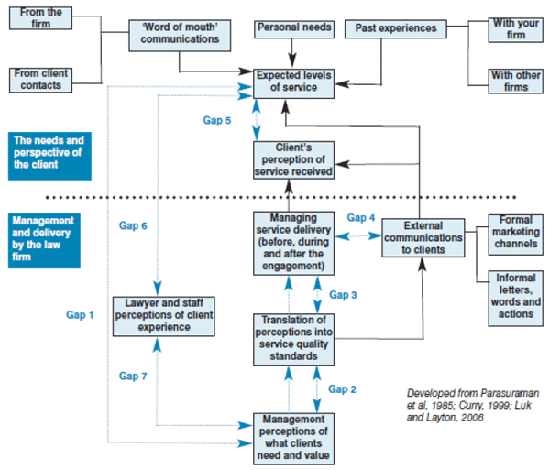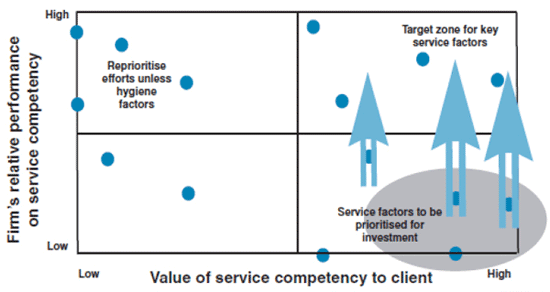Home » BLOG » Business Development » Live to Serve
Live to Serve
Published in Managing for Success, the magazine of the Law Society’s Law Management Section
Along with the other ‘traditional’ professions, law firms have witnessed real transformational changes in the last 25 years, in some cases willingly, but in many, as a response to market demands.
One of the most significant changes has been in lawyers’ attitudes to their clients. Firms have moved from a professional ethos of superiority to, and aloofness from clients, to an ‘intellectual’ ethos, where the focus is on using skills and knowledge to meet clients’ service requirements. However, under the surface, it is clear that old attitudes prevail, and this, combined with the lack of a coordinated approach to client service, makes the delivery of consistent service levels anything but straightforward.
While individual lawyers may have a strong, personal, service ethos, often delivering superb individual levels of client service, these examples too often represent heroic exceptions in what remains a cottage industry. Few firms have been able to achieve high levels of consistency in their service delivery. Fewer still have been able to exploit this position to build a brand which resides with the firm, rather than being associated almost wholly with individual practitioners.
Why is it important?
In this hyper-competitive environment, firms are coming under increasing pressure from both clients and rivals, current and new. This makes it ever more essential to stand out from the crowd.
Few can do this based on their ability to provide unique technical legal products. For the majority of firms, regardless of how things are dressed up by eloquent wordsmiths, strategy will centre on defining a credible market position and compelling client proposition, creating an appropriate and efficient operating platform, and managing client relationships. Consistent service quality is an essential part of making that a reality. A consistent approach also supports the firm’s ability to create an efficient business model, weed out duplication, and resource work at the right level. It shapes pricing, defines costs, and determines profitability. Getting service quality right will underpin the survival and prosperity of the firm.
So, achieving appropriate and consistent levels of service quality sits at the core of a law firm’s economic operating model, and defines its ability to attract and retain clients at the right fee levels. So why have law firms struggled to define, develop and implement service strategies which have stood the test of time (or, in many cases, even the test of implementation!), which approaches should firms consider, and how can the chances of success be maximised?
Where do firms fail on service delivery?
There are numerous interactions taking place between a firm and its clients, as well as within the firm itself. Failure in any one can lead to desired service levels not being achieved, and the firm more broadly being unable to operate in a consistent way.
To illustrate these interactions and potential sources of service quality failure, figure 1 (opposite) sets out a model adapted from the Servqual approach.
Figure 1: Potential law firm service quality gaps

The diagram highlights the gaps which can exist between the firm’s people and its clients in terms of perceptions and expectations of the firm’s services. It also shows the role of the firm’s people and its communication channels in managing and avoiding those gaps. By taking each of these gaps in turn, it is possible to dissect, analyse, design and better manage a firm’s service quality processes.
● Gap 1: Client expectations v management team perceptions
Management teams that do not invest in research (or do not take on board the results of the research they commission) can find themselves out of kilter with fast-changing client expectations of service. In a dynamic environment, expectations shift constantly, and the service innovation of last year becomes the norm of today. Other related issues include inadequate upwards communication within the firm, or too many layers of administration (and vested interests!), shielding or skewing information flows to the senior management team.
● Gap 2: Management team perceptions v service standards
The management team needs to be truly committed to meeting its own service standards, to ensure that the current and future needs of existing clients, and the anticipated needs of new clients, can be fully met. Without such commitment, there can be a perception that achieving the required service standards is unfeasible, or that there is slackness in setting stretching targets or insisting on high levels of consistency in delivery.
● Gap 3: Service standards v service delivery
Service delivery can fail to match up to the required service standards for a number of reasons, including lack of skills, resource shortages, poor technology support, poor team-working and inadequate supervision. For many law firms, the operational aspects of service delivery are particularly challenging, because they require professionals to conform to a standardised modus operandi. They also require those in management roles to acquire skills which do not form part of their professional training, and which they often do not relish.
● Gap 4: Service delivery v expectations set by external communication
The classic error of over-promising falls squarely into this area. Too many firms base their external communications on what they think the client wants to hear, without any grounding in the reality of the firm’s ability to deliver against such expectations. Consequently, many firms say the same thing, but few deliver on their promises.
● Gap 5: Client expectations v client perceptions
The level of service expected by each specific client is shaped by their own needs (or standards), past experiences with the firm (or other firms perceived as being similar) and what they have heard ‘on the grapevine’ or through word-of-mouth recommendation concerning the way in which the firm delivers its services. This gap arises when the firm is perceived by the client as falling short of meeting those expectations.
● Gap 6: Client expectations v staff perceptions
If staff don’t have a clear understanding of what service standards have been agreed, then it is unlikely that they will meet client expectations in an efficient way.
However, this does not necessarily mean that the firm will always under-perform against expectations. Many commercial clients are now prepared to trade off certain aspects of service to reduce fee levels but, at the same time, retain very high expectations in a small number of other areas which they consider as business-critical. If the firm’s staff do not understand that, the firm may over-perform in some areas (and carry the cost of doing so), but underperform in others (and perhaps incur a penalty).
● Gap 7: Staff perceptions v management team perceptions
Unless internal communications and systems ensure that both staff and the management team have a clear and shared understanding of what is required in terms of service standards, expectations and delivery, a shortfall will be inevitable.
Which aspects of service should we focus on?
All of a law firm’s various services and other defining features come together to make up how the law firm is viewed in the outside world. However, only some of these aspects can contribute significantly to the strategic positioning of the firm. Understanding which of the firm’s services and aspects fall into that category is crucial for those charged with developing strategy, and ensuring that limited resources are deployed to maximum effect.
There are three tiers of service to consider. First, there are those services and aspects which may be considered ‘table stakes’. These are the things which any competent firm must do or be, but which, in themselves, will not separate the firm from its competitors in the eyes of the client. In short, they are necessary, but not sufficient; their absence will act significantly against the firm, but their presence will not offer any unique advantage over the competition. Consequently, they are often referred to as ‘hygiene factors’ – while good hygiene will not make you healthier, its absence will almost certainly contribute to ill health.
The second and third tiers are linked – differentiating factors and determinant factors.
Many firms focus on building points of differentiation in their service quality model. However, this will not always be effective, as such exercises can be costly without actually adding any real value to the client experience. Most will be ‘nice to have’ but, in the final reckoning, tradable against a reduced fee or a similar, substitute aspect of service offered by a competitor.
Other services – a much smaller number – will be determinant. That is, they will be distinctive, unique and value-adding. These determinant factors provide the basis on which a firm can build strong relationships and resilient revenue streams. Figure 2 overleaf shows how you can work out, for your firm, which factors are determinant. Each ‘bullet’ represents a discrete aspect of service, to be mapped against two axes – the x axis of the value of the service to clients, and the y axis of the firm’s current performance, relative to its competitors, in that service. Shown in the bottom right quadrant are the services which are of high client value, but in which the firm currently underperforms. These may be the ‘determinant’ factors on which you are behind the competition; these are the services to prioritise for investment and improvement, so you can move from the bottom right quadrant to the top right one.
Figure 2: Mapping service competencies to client value

It would be equally easy to think that services to the left of the chart can be readily abandoned, to save resources which could then be diverted to improve performance in areas of more strategic significance. However, this is a superficial view. Some of these may be the hygiene factors to which we referred earlier, so further consideration will generally be needed before acting.
This model cannot, however, be used in isolation. Using this model, you might identify just one or two ‘silver bullets’ – areas to focus on to provide you with major competitive advantage and propel you well above your competitors. However, pinning all your hopes on improvements to just a few aspects of service can be a major mistake, as just a few minor failures can scupper the whole strategy.
In fact, being effective will often mean differentiating from your close competitors by being just a little better at a host of small things which, when combined, allow you to stand out from the pack in a way which is both valuable to clients and hard for competitors to replicate. In this sense, the service strategy may be thought of as being as much about recipes as ingredients.
This is where competitive intelligence comes in. You need to have an in-depth understanding of the firms with which you regularly compete. These are the players that your differentiation strategy needs to consider in the first instance, since it is with this relatively small group that you will fight most of your client acquisition and retention battles. Competitive intelligence will help you to identify opportunities and threats in your discrete marketplace.
It remains the case, however, that few firms undertake regular competitor analysis or performance benchmarking across both financial and non-financial variables. The scope of this article does not stretch to how to develop your competitive intelligence, which remains a key area for development in many firms – for more coverage on the topic, see the February 2011 edition of Managing for success.
How do we make it happen?
Managing partners will recognise, of course, that an intellectual debate on the merits of service quality improvements runs the risk of being perceived as just that by some of the partners. While there will be buy-in to the academic argument, emotional acceptance and, most importantly, behavioural change are much more difficult to achieve in practice.
The first stage of any change management process is to create a heightened sense of urgency – a burning platform. Those being asked to engage in change must understand the importance of the issues in play to their future – why change is needed, the implications of not changing, and the timescale for implementation of any changes.
There are a number of ways in which this burning platform can be ‘ignited’, but by far the most powerful is through the views and actions of clients. The incredible power of independent client feedback can be seen most forcefully in driving service improvement initiatives. Gathered through a simple but formal programme, the views of the client resonate most strongly with the partner group, and far more powerfully than pleas or coercion from the leadership team.
Do this sooner rather than later. After all, one very powerful form of client feedback is desertion to a competitor. It is to be hoped that managing partners tasked with building a strategy to deliver consistent service quality in their firms do not have to resort to saying ‘I told you so’ in order to demonstrate the need for immediate and fast-paced change.
Then, you need to keep the fire stoked, and that means embedding the strategy in the internal operations of your firm. The real challenge in managing service delivery lies not in gaining a good understanding of client needs or in the creation of systems or processes, but in changing behaviours, especially within the partner group which, in any firm, sets the tone and standards for everyone else. Partners have historically been highly self-directing and, for them, the challenge of adopting a common approach to service delivery will be considerable. Those who thrive in a culture which places a high value on individualism will inevitably rail against perceptions of conformity.
So, to make sure you get everyone on board with the strategy as part of their daily working lives, you need to link the service strategy to the firm’s reward and recognition system, and, from there, to individual performance measurement. The old management saying ‘what gets measured gets done’ still holds true. Making sure service quality is both measured and done means clearly stating the expectations of partners, fee-earners and staff in relation to client service, and setting objective standards against which performance can be measured. It also means providing appropriate training to make sure everyone has an understanding of the strategy, and the skills to contribute to it, and can, incrementally, make it a reality.
This article was published in November 2011 in the Managing for Success, the magazine of the Law Society’s Law Management Section. To read the original article click here.
Search
Categories
Recent Posts
- Fighting fit
- The Challenges Of Leadership Are Different To The Challenges Of Management
- The Cultural Dimensions Of Leveraging Institutional Knowledge
- A knowledge-led approach to business development is key to law firm resilience
- Team Morale Is Directly Linked To The Ability To Deliver Differentiated Client Services
